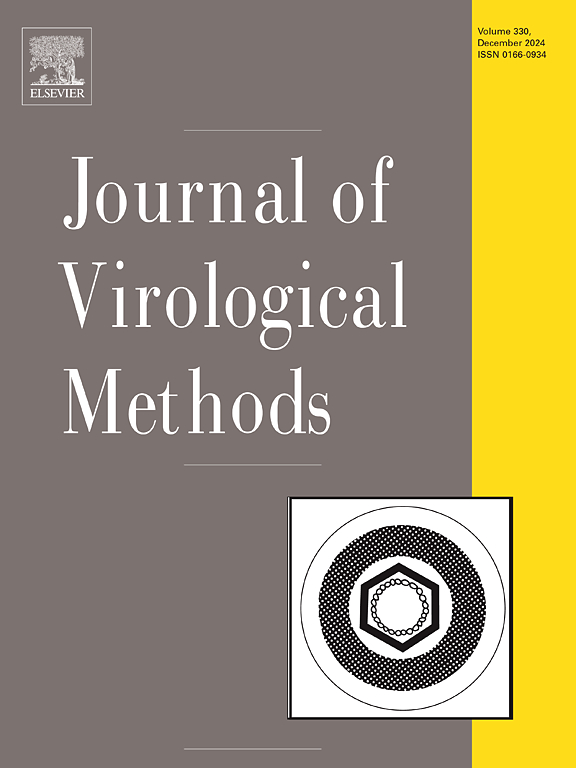严格筛选HTLV-1/2肽可以推动快速护理点检测的发展
IF 1.6
4区 医学
Q3 BIOCHEMICAL RESEARCH METHODS
引用次数: 0
摘要
人类t细胞嗜淋巴病毒(HTLV-1/2)引起被忽视的感染,从而引发危及生命的疾病,全世界感染人数被低估。即时检测(POCT)有助于确定携带者,及时和具有成本效益地控制感染的传播,包括受影响最严重的地区和易感人群,以及制定公共卫生政策,包括控制垂直传播。在对HTLV-1和HTLV-2的Env、Gag和Tax蛋白进行硅晶分析后,我们合成并表征了用于筛选抗HTLV-1/2抗体的多肽,具有较高的敏感性和特异性。选择的173个多肽通过免疫印迹和间接的内部ELISA进行筛选。在识别感染个体HTLV-1或HTLV-2血清中表现最好的肽是Gag-HTLV-1和Gag-HTLV-2,它们是非常好的筛选试验候选者。Tax-HTLV-1和Env-HTLV-2多肽对HTLV-1和HTLV-2具有较高的敏感性和特异性。这里显示的HTLV-1/2肽的筛选,包括使用hiv感染者和血清阴性的血清,对于避免在最终的试点测试中使用非特异性反应的肽,以及达到在巴西监管机构注册的即时护理测试至关重要。本文章由计算机程序翻译,如有差异,请以英文原文为准。
Strictly screening of HTLV-1/2 peptides can drive the development of rapid point-of-care tests
The Human T-cell lymphotropic virus (HTLV-1/2) cause neglected infections that drives life-threatening diseases and the numbers of infected people around the world are underestimated. Point-of-care tests (POCT) are useful to identifying carriers, to controlling the infection’s spread with timely and cost-effectiveness, to include the most affected areas and susceptible populations, and the establishment of public health policies, including the control of vertical transmission. After in silico analysis of Env, Gag and Tax proteins of HTLV-1 and HTLV-2, we synthetized and characterized peptides to screening antibodies anti-HTLV-1/2 with high sensitivity and specificity. The 173 peptides chosen were screened by immunoblot, and by indirect in-house ELISA. Peptides that had best performed in recognize both, HTLV-1 or HTLV-2 sera from infected individual, were Gag-HTLV-1 and Gag-HTLV-2 showing to be very good candidates for screening tests. Peptides of Tax-HTLV-1, and Env-HTLV-2 had discriminated sera from HTLV-1 and HTLV-2 with high sensitivity and specificity. The screening of HTLV-1/2 peptides showed here, including the use of sera from HIV-infected individuals along with seronegative ones were crucial to avoid the use of peptides with unspecific reaction in the final pilot tests, and to reach the Point-of-care test that is under registration at regulatory Brazilian agency.
求助全文
通过发布文献求助,成功后即可免费获取论文全文。
去求助
来源期刊
CiteScore
5.80
自引率
0.00%
发文量
209
审稿时长
41 days
期刊介绍:
The Journal of Virological Methods focuses on original, high quality research papers that describe novel and comprehensively tested methods which enhance human, animal, plant, bacterial or environmental virology and prions research and discovery.
The methods may include, but not limited to, the study of:
Viral components and morphology-
Virus isolation, propagation and development of viral vectors-
Viral pathogenesis, oncogenesis, vaccines and antivirals-
Virus replication, host-pathogen interactions and responses-
Virus transmission, prevention, control and treatment-
Viral metagenomics and virome-
Virus ecology, adaption and evolution-
Applied virology such as nanotechnology-
Viral diagnosis with novelty and comprehensive evaluation.
We seek articles, systematic reviews, meta-analyses and laboratory protocols that include comprehensive technical details with statistical confirmations that provide validations against current best practice, international standards or quality assurance programs and which advance knowledge in virology leading to improved medical, veterinary or agricultural practices and management.

 求助内容:
求助内容: 应助结果提醒方式:
应助结果提醒方式:


